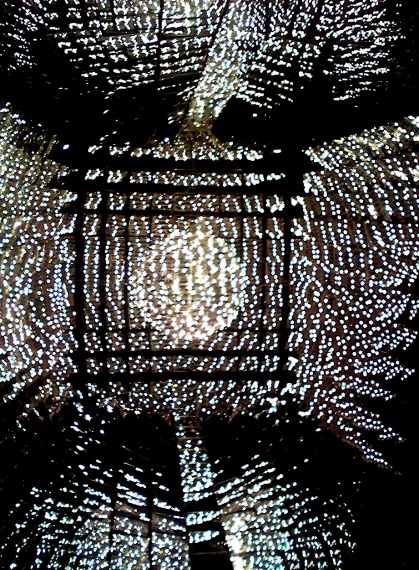Filed under: Uncategorized | Tags: 2009, art, art in containers, Biennale, Kobe, meriken park

I’m usually not a huge fan of installation art–I find it too often grays the area between art and furniture. Not that the two mediums are mutually exclusive. Instead, I would say that it’s extremely difficult to be just a good artist or just a good interior designer. The ambitious blending of these two fields tends to result in things like pieces of garbage hanging from the ceiling with fishing line or chairs made of broken glass.
That in mind, this weekend I went to Kobe Biennale art exhibition. The exhibition takes place at many sites through the city, however the focal point was in Meriken Park, at the Port of Kobe. There, organizers had a erected a small, improvised outdoor museum.
The highlight of the Biennale was the “Art in Containers” International Exhibition. Thirty contemporary artists–all who have some connection to Kobe–were chosen, and each were tasked with creating an installation piece inside a 40 ft. deep shipping container.
As I said before, I am not a huge fan of installation art; however, I do think the utilization of shipping containers buoyed the effectiveness of some of these pieces. Having a defined space provided a clear segmentation between each piece while elegantly condensing and focusing some of the art in a manner that enhanced the experience.
That’s not to say that I loved every piece. Some of them were the typical over-thought and under executed installations that modern art is often criticized for. There was the boring 3-D animation from the early 90’s on a wall container, and another that was simply a dark space with weird sounds. I actually didn’t stay in the any of the darkened containers for any extended period of time. I’ve seen to many crime shows to feel safe when alone in a pitch-black shipping container; at any moment the door could slam shut and not reopen until days later some detective finds your frozen, dead body in Arkhangelsk and he then has to get in his Lieutenants face just to start making inquiries with the local organized crime syndicates.
On the whole, many of the installations were interesting. My particular favorite involved a container where the walls and ceiling were covered in tiny wall clocks. The sound of hundreds of clocks ticking simultaneous was one of those unique art experiences (clock shops excluded). Also, a in the container at the same time as me lady had the audacity to touch one of the clocks. Of course, the clock she touched and another fell off the wall and shattered on the floor. I somehow was able to catch the entire spectacle from her initial arm extension to her sever and instantaneous reaction of regret (it’s a universal expression). I don’t really like performance art either but this was like my own private candid camera show, except for the part where she actually looked at me and I had to quickly reply “daijobu” (everything is okay).
Also, this is Japan, so there was some cool large scale origami. There were other containers that had a more circus atmosphere–funny mirrors and one with just a bunch of fans and mounds of confetti that you could play in. While one might dispute the artistic endeavor of these installations, the fun quotient of them can really be debated.
This Chris Farely skit presents one of the many global stereotypes of Japanese television. If one were to put them all together the caricature created would be twenty-four hours of anime and shock and awe game shows. With any stereotype, there is some truth to it. Yes, there is anime, and yes there are shows where comedians get dunked into a tank of eels or have wasabi shot directly up their nose for reasons I still don’t understand (actually, the reason is pain is funny). However, in between, Japanese airwaves are filled with a mixture of programming that not much different from any other Western Country’s.
There are still many cultural nuances to Japanese television that remain a mystery to me. One thing I have come to understand is that there is a larger percentage of shows in Japan on mainstream channels that are devoted to being informative as well as entertaining. Celebrities often appear on roundtable type shows where they present documentaries or examine surprising facts. There is a real emphsis on the show being a learning experience. Of course, just as I typed that a program showed video of a cat that says “arigato” when it eats.
Within the last fews years (according to my Japanese Teacher) Kanji quiz shows have become quite popular. Kanji, which are the adopted Chinese characters, are one of the three systems of writing in Japanese. There are about 2,000 “daily use” Kanji that every Japanese person is expected to know upon graduating High School, but there are many more beyond that Kanji can be very difficult to learn because most characters have multiple pronunciations that are used depending on the context. Also many Kanji can share the same sound, yet have a different meaning.
In these game shows often the objective of is simply to spell the Kanji correctly using Hiragana–a phonetic alphabet. In most cases, the contestants on then show are famous comedians, actors of athletes. They are not scholars by any means and the mixture of questions ranges from simple immensely difficult. Many comedians have made a name for themselves by simply displaying a good sense of humor about being dumb. While there is a clear objective to the game there are often no prizes for winning. Rather the prize is simply the television exposure provided by being on the show.
As you can see from this clip, while it’s a stylized competition the production value is not exactly extravagant. In this clip the members of a team are trying to spell certain Kanji in Hiragana and get farther into the game than the two competing teams (seen mocking them on a separate stage).
From a cultural standpoint, I find it fascinating that a show like this popular. I can’t imagine what is essentially a prizeless celebrity spelling contest being a ratings draw in America. Recent trends suggest Americans would rather watch an average-joe partake in a high-stakes match of wits that requires the contestant to only have a rudimentary grasp of some basic math to succeed… and yes, I I’ll admit I was a sucker for it too, I blame Howie Mandel.
Filed under: Uncategorized | Tags: bad ideas, crazy, haircut, Japan, jumper, self-haircut, shopping
This is easily the most amusing thing I have found in Japan. Be nice or it is also your Christmas present.

This is not what Back to the Future II had in mind
I found this contraption (The name appears to be haircut jumper-for Men) in the bargain section of JUSCO (The Japanese equivalent of Walmart). The first time I walked by it caught my attention but I was in such rush that I didn’t stop to examine it. I intially thought it was somesort of vest used for doing laundry. A week later I had to fortune to come across it again and this time I was able to stop and realize that while my laundry-vest idea was absurd this self-haircut cleaning vest surpassed it on the absurdity meter in a most spectacular manner.
I can’t tell you how delighted I am to learn that there is a gift out there for the person who hates paying for a haircut but is bothered by the mess created by cutting their own hair at home. Also this person would have to be of the opinion that garbage bags, newspapers, brooms, vacuums and affordable plastic sheeting all do an inferior job of hair-waste management .
I do have some questions though;
1. Why is this product marketed to people cutting their own hair? Theoretically, couldn’t this product be used by a person cutting someone else’s hair that doesn’t want to clean up the mess.
2. If someone is so cheap that they cut their own hair, are they really the type of people that are going to shell out the cash about $13) for a hair-catching vest? Are they really going to be able to justify this purchase?
3. It appears that for this “device” (I use that term loosely) to be effective you have to cut your hair standing up. Do not named Richie Tenenbaum people cut their hair standing up?
4. How do you cut the back?
5. Doesn’t it look like this guy on the package is smiling just a bit too much?
6. Does the vest qualify as appropriate attire for casual fridays? or is it too formal?








